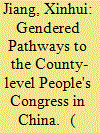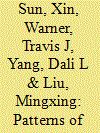| Srl | Item |
| 1 |
ID:
184719


|
|
|
|
|
| Summary/Abstract |
Women are underrepresented in legislature almost worldwide, and China is no exception. Although the Chinese Communist Party (CCP) implemented its first gender quota in 1933, gender quotas and women's representation in China remain understudied. This study fills the literature gap by examining the subnational variation in gender quota implementation and women's representation in the county-level people's congresses (CPC). Through a comparison of four county-level units in Hunan and Hubei with similar socioeconomic features yet contrasting results in the numbers of female representatives elected in the 2016 CPC election, this study argues that women's access to CPCs is affected by the CCP's adoption and enforcement of grassroots quotas. The fieldwork shows that although all cases introduced a 30 per cent gender quota, only CPCs in Hunan province were able to meet the quota requirements. This was because the grassroots quota threshold was raised in Hunan and strictly enforced, partly as a response to the 2013 Hengyang vote-buying scandal. In contrast, CPCs in Hubei province nominated a large number of “first hands” (yibashou) candidates, very few of whom were women.
|
|
|
|
|
|
|
|
|
|
|
|
|
|
|
|
| 2 |
ID:
123695


|
|
|
|
|
| Publication |
2013.
|
| Summary/Abstract |
A 'dual-power structure' governs the Chinese countryside. Branch committees of the Chinese Communist Party, traditionally the centers of power in the villages, increasingly share their authority with elected villagers' committees. Seeking to illuminate the factors contributing to the division of authority between these 'two committees', we view Party branch secretaries and the chairs of villagers' committees as the agents of two distinct principals. Party branch secretaries tend to derive their authority from township authorities, while villagers' committee chairs derive theirs from their village electorates. We predict that the division of authority between the two committees varies with (a) the relative levels of activism exhibited by the principals; and (b) the perceived legitimacy of the agents, as determined by their method of s/election. Through analysis of a unique dataset, we test four hypotheses derived from this framework. Our findings contribute to a better understanding of the 'exercise of power' in rural China and shed light on the dynamics of China's political evolution.
|
|
|
|
|
|
|
|
|
|
|
|
|
|
|
|